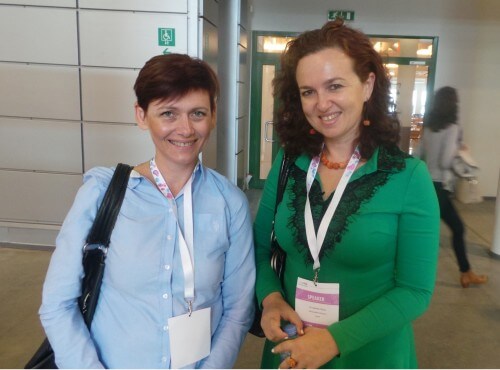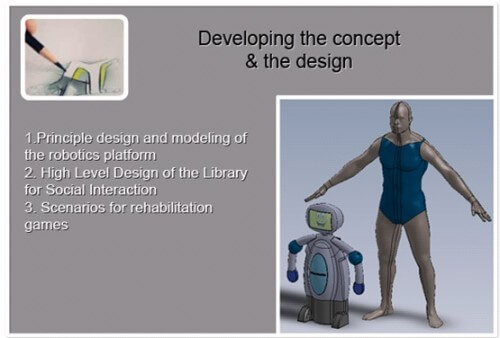The company is based on algorithms that allow the robot to recognize human emotions, developed by Dr. Marina Fridin, former head of the robotics laboratory at Ariel University; An interview with Fridin and the CEO of the company Natasha Shukin, at the Life Sciences Baltics conference

Among the Israeli companies that presented at the Life Science Baltics conference held last week in Vilnius, the capital of Lithuania, was a company whose name alone brought us back to childhood - Avracadbra Robotics. Dr. Marina Fridin, former head of the robotics laboratory at Ariel University presented algorithms that allow a robot to recognize human emotions, which she developed.
In an interview with the scientist website at the Life Sciences Baltics conference, the CEO of the company, Natasha Shokin, explains that the possibility of a robot to recognize the emotions of the person sitting in front of him - whether he is happy, sad, thoughtful, focused, etc. according to his hand gestures, body movements, speech, etc. , there is great value in the use of robots as therapists, coaches, teachers, non-contact physical therapists, speech therapy, occupational therapy, professions that are essential to spur the person on, give the right motivation, manage the therapeutic or educational process for him, and thereby advance him to the next level . In particular, this is important when developing robots that will talk to cerebral palsy victims in the first year after the accident or event that caused it, in order to force them to use the damaged part of their brain, thus rehabilitating it.
Dr. Pridin, completed a doctorate in computer science and applied mathematics at the Weizmann Institute (with Prof. Tamar Flesh), after which she was offered to open a laboratory in the field of robotics in Ariel. As part of her doctoral thesis, she built algorithms to identify human emotions through body gestures, movement, etc. Dr. Friedin explains: "The goal was to give the features to the robot as an input that allows it to understand the mental and emotional state of the person and behave accordingly - not to be happy when you have a depressed person next to you, and not to be stubborn around stubborn people. The laboratory at Ariel University dealt in a field known as Social Assistive Robotics, a field that has been developed for about a decade by Prof. Maya Matrick from UCLA. The concept speaks of the fact that in the human world most professions are professions that help people and are carried out through guidance, not through physical contact. There is no reason that by building the right models and artificial intelligence it is impossible to give these capabilities to a robot. A robot doesn't just have to mop the floor and carry goods off the shelves."
When Dr. Friedin opened the laboratory in Ariel, she studied the behavior of children with cerebral palsy and healthy children in front of them, when they sit in front of a robot that tells them what to do and responds to their words. According to her, there have been several cases where children with cerebral palsy, who suffer from both mental retardation and paralysis, due to damage to large areas of their brain. In the video she presented, she showed how a paralyzed girl moves her hands after the robot played her the song "hands up on her head", but she adds that even healthy children were motivated to learn new things that they didn't get in the conventional teaching process.

Shukin: "The works with children with cerebral palsy have received a lot of resonance, so far Fridin has published 19 articles and publications in scientific press and conferences. At some point after very dramatic experiments were conducted that showed how the robot can change the worlds of the disabled and the parents of the children asked to keep the robot that improved the children's condition, but this was not possible because it is laboratory equipment that requires a close technician."
At the beginning of 2013, Dr. Friedin left the laboratory, founded the start-up company Abrahkadbra Robotics, and appointed Mashukin to manage the business side. "We built a model that will allow adults with cerebral palsy lesions to rehabilitate. We also decided that some of the technologies: voice recognition, conversation and speech systems, and computer vision are not developed by ourselves, but purchased off the shelf and integrated.
"The audience we are addressing are adults with cerebral palsy who require long-term rehabilitation. This follows studies that prove that if these patients are provided with an intensive rehabilitation therapeutic process in the first year after the injury, they can fully or almost fully return to their lost abilities, because the neurological pathway in the body is still present.
"Marina's expertise is taking the knowledge of the professionals and turning them into algorithms that guide the robot in its behavior, placing the input from the human behavior on the axis of the algorithms as well as giving a relevant response to the person on the other side and in this way producing in-depth and continuous work.
What stage is the company at now?
Shukin: "We are in the development phase of the concept and design, including principles of planning and modeling of a robotic platform (the robot with which Dr. Fridin worked is suitable in size and shape for child care), detailed planning of libraries for social interaction of robots and humans, and development of scripts for rehabilitation games - with the assistance of the physical therapist, Dr. Mark Delakpotov. We are a ten-month-old startup, we received support from the scientist and invested money from home. Now we are in a recruitment round and negotiations with incubators."

2 תגובות
I still prefer my dog,
It recognizes both tone of voice and body gestures, not to mention the other advanced sensors it has in its nose
Does not require a close technician and complicated algorithms, just a bowl of bonzo now and then.
Hocus Pocus Ltd.!
Founder: Harry Potter